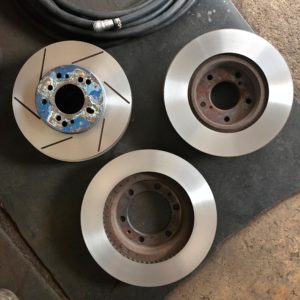Brake rotors are big circular discs that sit behind your wheels. The rotors provide a surface for the brake calipers and pads to grip and create friction. These rotors are made from steel or cast iron, which can produce a lot of friction while withstanding regular use.
You can view your brake rotors just by peering through your vehicle’s wheels. As you use your brakes, the rotors will wear out. Luckily, brake rotors have a very long lifespan, lasting up to 60,000 miles, but brake rotors can last longer or shorter depending on their use.
Continuing to use a worn brake rotor can affect your safety. That begs the question, what are the signs of bad brake rotors? How to tell if your vehicle’s brake rotors are bad?
Visible Brake Rotor Symptoms
Lines or Grooves Running Along the Brake Rotor’s Surface
It’s normal for brake rotors to have visible grooves or scratches. However, these scratches will gradually become deeper after prolonged use. Faint scratches are probably not going to be concerning. However, if the scratches are deep or the rotor has cracks, it’s time for a replacement.
Sometimes, the brake rotor will also be scored. What’s scoring? This happens when the brake pads run out of material and metal starts grinding against the brake rotor, creating deeper lines.
Cracked Rotors
You’ll likely feel or hear cracked rotors before you see them. Cracked rotors typically make loud banging noises or pulsate on the brake pedal. If your brake rotor has a crack, then it’s considered destroyed and you should replace it immediately. Continuing to drive with a cracked rotor can compromise your safety because the rotor can disintegrate and cause brake failure.
Excessive Rust
If you frequently peek at your brake rotors, you might notice that they can rust. Brake rotors are typically made from cast iron or steel, which can rust quite easily when exposed to moisture or salt. This shouldn’t be concerning because the friction from the brake pads should clean them off during use.
However, there’s a threshold when the brake rotors can accumulate so much rust that it affects the rotors’ structure, weakening them. Eventually, the rust can carve off too much metal and cause pitting, affecting braking and making noise.
Brake Rotors Turned Blue
Brake rotors can turn blue when they overheat. This can happen if the brakes were excessively used during a mountain descent or if you were driving your vehicle on the track. However, some high-performance brake rotors are perfectly usable even if they turn blue. Some rotors are designed to handle high temperatures. Hence, high heat exposure won’t cause these rotors to warp.
However, most vehicle rotors will warp when they turn blue. Warped rotors are considered worn and can be a safety issue since they’ll cause issues such as excess vibrations while braking, which is unsafe. Sometimes, blue rotors can even be caused by overheating due to improper installation.
Brake Rotors Are Too Thin
Just like the brake pads, the brake rotors will also lose material over time. Eventually, the friction will cause the brake rotors to become too thin.
You’ll need to measure your brake rotor’s thinnest spot using a micrometer. Most rotors have a minimum operating thickness. If the brake rotor has worn past this thickness, then you need new rotors.
Rotor Symptoms on Brake Feel and Performance
Vibrating or Pulsating Sensation During Braking
Pulsating or vibrating brakes are the most common warped brake rotor symptoms. Pulsating brakes mean the brake rotors don’t have a flat contact surface with the brake pads. Instead, the rotor surface can have small curves and indents which can cause the brake pad and caliper to vibrate. Sometimes the uneven surfaces will vibrate the pads and caliper so much that you’ll feel the vibrations on the brake pedals and even your steering wheel.
Squealing Noises
Squealing or screeching noises happen because the brake pads rub against an uneven brake rotor. This means some portions of the rotor have less metal, while some parts have more. When there are a lot of uneven surfaces on a brake rotor, the contact patch between the rotor and the pad becomes smaller, causing a screeching noise.
Reduced Braking Performance
This is the most obvious symptom of an old and worn-out brake rotor. You might notice this when stopping at an intersection and you notice that the brakes might require more input before slowing down your vehicle. Worn-out brake rotors cause reduced performance because they can become uneven, resulting in less contact and therefore less friction with the brake pad.
Can You Drive With Bad Brake Rotors?
If you think your rotors are bad, ask a mechanic to inspect your brakes immediately. Brake rotors play a significant role in your vehicle’s braking system and driving with a faulty rotor is unsafe. Driving at higher speeds is going to be risky because you’ll have reduced stopping power. Plus, there’s a chance your vehicle might have brake failure
Any information provided on this Website is for informational purposes only and is not intended to replace consultation with a professional mechanic. The accuracy and timeliness of the information may change from the time of publication.


































